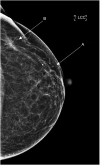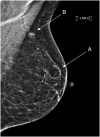Core needle biopsy causing a pseudoaneurysm in the breast
- PMID: 34730422
- PMCID: PMC10335138
- DOI: 10.1308/rcsann.2021.0099
Core needle biopsy causing a pseudoaneurysm in the breast
Abstract
Core needle biopsy (CNB) is the first-choice method of sampling suspicious, focal breast lesions for histological analysis. Here we present the case of a 65-year-old woman who was recalled for evaluation of the left breast following a screening mammogram. An ultrasound-guided biopsy was performed using a disposable core biopsy needle and 3 weeks later a magnetic resonance imaging scan showed a distended vessel with adjacent sac measuring 17 × 15mm2. A Doppler ultrasound scan confirmed pseudoaneurysm. A review of the literature was made on breast pseudoaneurysm following CNB, and over the past 20 years there were few other reports. Pseudoaneurysms in the breast are a rare but serious complication of CNBs. They may spontaneously thrombose, but often require intervention, so it is essential that clinicians are aware of the risk.
Keywords: Breast; Core needle biopsy; Pseudoaneurysm.
Figures








References
-
- NHS Breast Cancer Screening Program (NHSBSP). Clinical Guidance for Breast Cancer Screening Assessment. NHSBSP Publication No 49. PHE publications gateway number 2016426. 2016 Nov.
Publication types
MeSH terms
LinkOut - more resources
Full Text Sources
Miscellaneous

